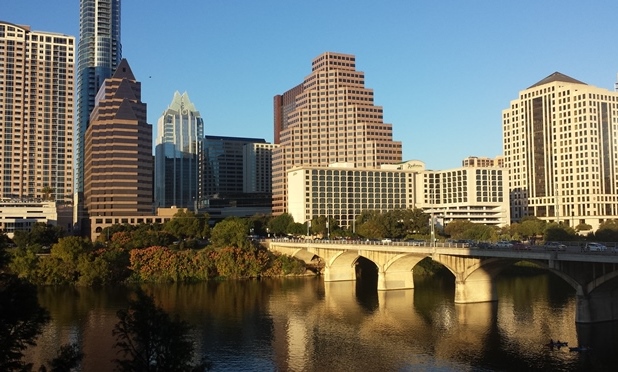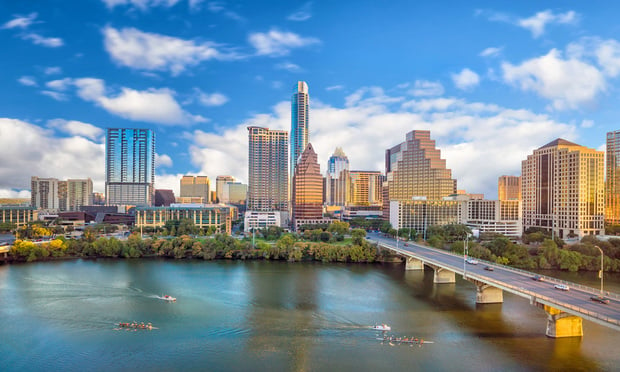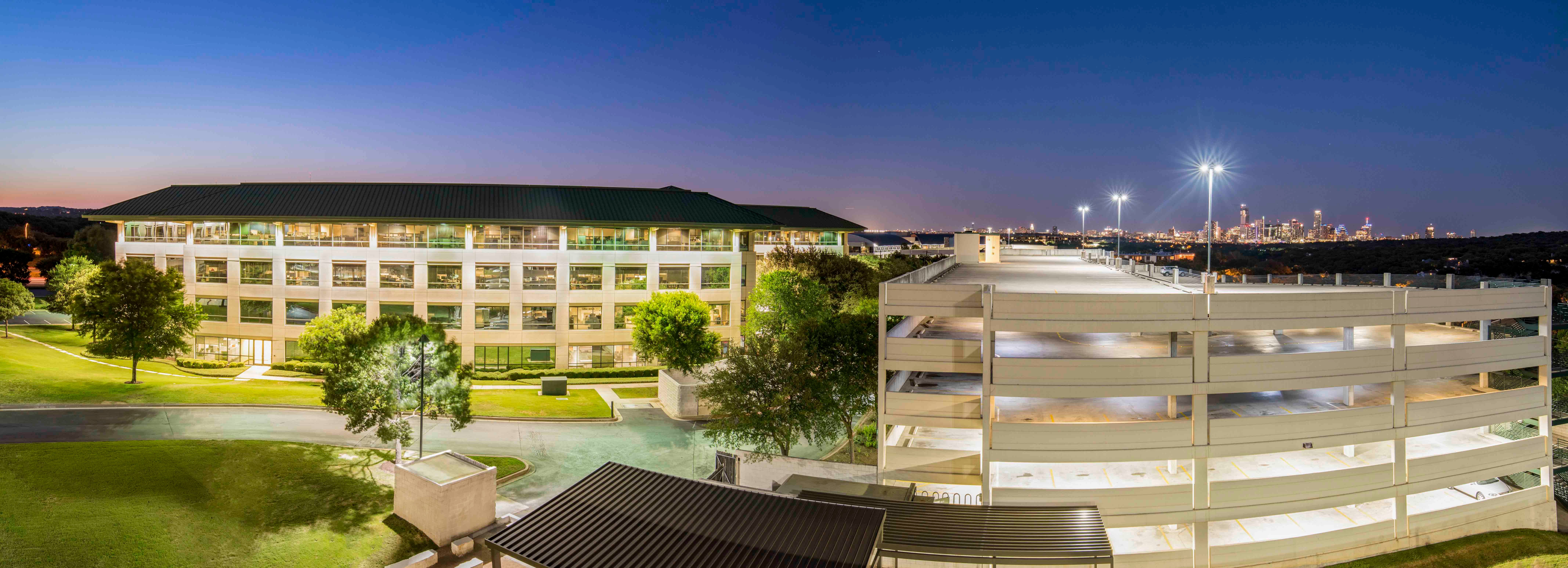
AUSTIN, TX—Proposition 1, a $720 million mobility bond package designed to improve traffic in Austin, passed in this week's election. In an effort to improve Austin's major traffic issues, a three-pronged plan of local neighborhood projects, regional highway projects and the central corridor projects represents an attempt to spread the work and the benefits geographically and multimodally. A breakdown of the costs as outlined by the Austin Capital Planning Office includes $101 million for regional mobility projects, $482 million for corridor improvement projects and $137 million for local mobility projects, GlobeSt.com learns.
Regional Mobility Projects
Allow the city to address intersections on Loop 360 at Westlake Drive, Courtyard Drive, FM 2222, Lakewood Drive and Spicewood Springs Road/Bluffstone Drive. Improvements may include signal modifications, changes to the design of medians and installation of accessible pedestrian facilities.
Allow the city to fund improvements on Spicewood Springs Road east of Loop 360. Improvements may include a roadway expansion, signals, medians, sidewalks, bike facilities and driveway reconstruction.
Allow the city to address Anderson Mill Road from Spicewood Parkway to US Hwy 183, the intersection of RM 620 and FM 2222, and Parmer Lane between SH 45 to Brushy Creek Road. Improvements may include projects to increase pedestrian, bicycle and vehicular mobility.
Allow the city to fund design and replacement of the Old Bee Caves Road Bridge crossing Williamson Creek.
Corridor Improvement Projects
Allow the city to address implementation of corridor mobility reports, which identify short-, medium and long-term transportation improvements on North Lamar Boulevard from US Highway 183 to Howard Lane, Burnet Road from Koenig Lane to MoPac Expressway, Airport Boulevard from North Lamar Boulevard to US Highway 183, East Martin Luther King Jr. Boulevard/FM 969 from US Highway 183 to Decker Lane, South Lamar Boulevard from Riverside Drive to Ben White Boulevard/US Highway 290 West, East Riverside Drive from Interstate 35 to State Highway 71, Guadalupe Street from Martin Luther King Jr Boulevard to West 29th Street, Slaughter Lane and/or William Cannon Drive
Projects along these corridors may include intersection improvements, such as signals, turn lanes, pedestrian crossings; sidewalks, bicycle facilities, transit, bus stops and drainage.
Allow the city to develop corridor mobility reports (preliminary engineering) for William Cannon Drive, Slaughter Lane, North Lamar Boulevard/Guadalupe Street, East Rundberg Lane, West Rundberg Lane, Colony Loop Drive, East Martin Luther King Jr Boulevard/FM 969, South Congress Avenue, Manchaca Road and South Pleasant Valley Road.
Local Mobility Projects
Allow the city to address sidewalks based on the 2016 sidewalk master plan/Americans with Disabilities Act Transition Plan, with a focus on sidewalks rated as “very high” or “high” priorities. Improvements may include installation of new curb ramps, sidewalks, curbs, driveway aprons and related construction and rehabilitation/replacement of existing curb ramps, sidewalks, curbs, driveway aprons and related construction to conform with the Department of Justice guidance and ADA requirements.
Allow the city to address safe routes to school with $27.5 million to be divided evenly among the 10 city council districts. This is a partnership with local school districts to address safety concerns of routes to school and encourage children and families to bike or walk to school. Improvements may include infrastructure options that create a safer environment such as sidewalks, traffic calming devices, protected bicycle facilities and urban trails.
Allow the city to address urban trails with a transportation and mobility purpose with $26 million. The urban trail network is a citywide network of non-motorized, multi-use pathways that provide important accessible routes for transportation and recreation for all ages and abilities.
Allow the city to address bikeways with a transportation and mobility purpose with $20 million. The bicycle master plan includes recommendations for complete streets that accommodate bicyclists of all ages and abilities. Improvements may include separated and/or protected bicycle facilities, bicycle detection and signal equipment, and other on-street bicycle facilities, such as bike lanes.
Allow the city to fund improvements for substandard streets/capital renewal projects with $11 million. Substandard streets are publically owned roadways that do not meet current Austin requirements because of pavement widths that are less than 24 feet across and typically lack some curb and gutter, drainage, bicycle facilities and sidewalk infrastructure.
Preliminary engineering is to be performed for Brodie Lane, Circle S Road, Cooper Lane, FM 1626, Johnny Morris Road, Latta Drive/Brush Country, Ross Road and Rutledge Spur. These projects would include preliminary engineering for future design and construction projects that would aim to address the existing substandard street conditions as well as increase connectivity and capacity for all roadway users.
Allow the city to address implementation of fatality reduction strategies for projects listed on the top crash location intersection priorities improvement list for $15 million.

AUSTIN, TX—Proposition 1, a $720 million mobility bond package designed to improve traffic in Austin, passed in this week's election. In an effort to improve Austin's major traffic issues, a three-pronged plan of local neighborhood projects, regional highway projects and the central corridor projects represents an attempt to spread the work and the benefits geographically and multimodally. A breakdown of the costs as outlined by the Austin Capital Planning Office includes $101 million for regional mobility projects, $482 million for corridor improvement projects and $137 million for local mobility projects, GlobeSt.com learns.
Regional Mobility Projects
Allow the city to address intersections on Loop 360 at Westlake Drive, Courtyard Drive, FM 2222, Lakewood Drive and Spicewood Springs Road/Bluffstone Drive. Improvements may include signal modifications, changes to the design of medians and installation of accessible pedestrian facilities.
Allow the city to fund improvements on Spicewood Springs Road east of Loop 360. Improvements may include a roadway expansion, signals, medians, sidewalks, bike facilities and driveway reconstruction.
Allow the city to address Anderson Mill Road from Spicewood Parkway to US Hwy 183, the intersection of RM 620 and FM 2222, and Parmer Lane between SH 45 to Brushy Creek Road. Improvements may include projects to increase pedestrian, bicycle and vehicular mobility.
Allow the city to fund design and replacement of the Old Bee Caves Road Bridge crossing Williamson Creek.
Corridor Improvement Projects
Allow the city to address implementation of corridor mobility reports, which identify short-, medium and long-term transportation improvements on North Lamar Boulevard from US Highway 183 to
Projects along these corridors may include intersection improvements, such as signals, turn lanes, pedestrian crossings; sidewalks, bicycle facilities, transit, bus stops and drainage.
Allow the city to develop corridor mobility reports (preliminary engineering) for William Cannon Drive, Slaughter Lane, North Lamar Boulevard/Guadalupe Street, East Rundberg Lane, West Rundberg Lane, Colony Loop Drive, East Martin Luther King Jr Boulevard/FM 969, South Congress Avenue, Manchaca Road and South Pleasant Valley Road.
Local Mobility Projects
Allow the city to address sidewalks based on the 2016 sidewalk master plan/Americans with Disabilities Act Transition Plan, with a focus on sidewalks rated as “very high” or “high” priorities. Improvements may include installation of new curb ramps, sidewalks, curbs, driveway aprons and related construction and rehabilitation/replacement of existing curb ramps, sidewalks, curbs, driveway aprons and related construction to conform with the Department of Justice guidance and ADA requirements.
Allow the city to address safe routes to school with $27.5 million to be divided evenly among the 10 city council districts. This is a partnership with local school districts to address safety concerns of routes to school and encourage children and families to bike or walk to school. Improvements may include infrastructure options that create a safer environment such as sidewalks, traffic calming devices, protected bicycle facilities and urban trails.
Allow the city to address urban trails with a transportation and mobility purpose with $26 million. The urban trail network is a citywide network of non-motorized, multi-use pathways that provide important accessible routes for transportation and recreation for all ages and abilities.
Allow the city to address bikeways with a transportation and mobility purpose with $20 million. The bicycle master plan includes recommendations for complete streets that accommodate bicyclists of all ages and abilities. Improvements may include separated and/or protected bicycle facilities, bicycle detection and signal equipment, and other on-street bicycle facilities, such as bike lanes.
Allow the city to fund improvements for substandard streets/capital renewal projects with $11 million. Substandard streets are publically owned roadways that do not meet current Austin requirements because of pavement widths that are less than 24 feet across and typically lack some curb and gutter, drainage, bicycle facilities and sidewalk infrastructure.
Preliminary engineering is to be performed for Brodie Lane, Circle S Road, Cooper Lane, FM 1626, Johnny Morris Road, Latta Drive/Brush Country, Ross Road and Rutledge Spur. These projects would include preliminary engineering for future design and construction projects that would aim to address the existing substandard street conditions as well as increase connectivity and capacity for all roadway users.
Allow the city to address implementation of fatality reduction strategies for projects listed on the top crash location intersection priorities improvement list for $15 million.
© 2025 ALM Global, LLC, All Rights Reserved. Request academic re-use from www.copyright.com. All other uses, submit a request to [email protected]. For more information visit Asset & Logo Licensing.









